1900's - The Edwardian PeriodGrooming and Corsets 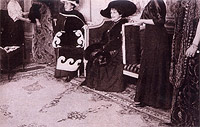 Styling and grooming for the Edwardian lady began with her underwear, more particularly her corset. In an effort to achieve the period’s coveted tiny waist, ladies would grip an overhead ‘lacing bar’ while their corset strings were tied. Concern over the physical damage corsets caused to the human body was protested by reform groups, resulting in innovations such as the electric corset. Styling and grooming for the Edwardian lady began with her underwear, more particularly her corset. In an effort to achieve the period’s coveted tiny waist, ladies would grip an overhead ‘lacing bar’ while their corset strings were tied. Concern over the physical damage corsets caused to the human body was protested by reform groups, resulting in innovations such as the electric corset.
As well as selling corsets on their upper floors, away from the prying eyes of gentlemen shoppers, department stores such as Mappin & Webb provided a range of new grooming products, including the disposable safety razor. Invented in 1901 by American businessman King Camp Gillette, the razor helped lead to a decrease in the popularity of beards. |
Children’s Books 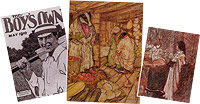 There is a tendency to look back on the Edwardian era as a lost golden age, especially for children. Nursery teas and nannies, seaside holidays and magical adventures come down to us captured in the evocative illustrations of Arthur Rackham, Edmund Dulac and the Robinson brothers Thomas, Charles and William Heath. There is a tendency to look back on the Edwardian era as a lost golden age, especially for children. Nursery teas and nannies, seaside holidays and magical adventures come down to us captured in the evocative illustrations of Arthur Rackham, Edmund Dulac and the Robinson brothers Thomas, Charles and William Heath.
This was the heyday of the storybook, with ‘The Wind in the Willows’, ‘Peter Rabbit’. ‘The Railway Children’, ‘The Secret Garden’ and Rudyard Kipling’s ‘Just So Stories’ making their first appearance. All this was in marked contrast to reality for the vast majority of children, struggling towards adulthood amidst poverty and disease. For poor Edwardians, childhood ended in the early teens as they left school, while for workhouse children it never really began. |
Detergent and Cleaning Compounds 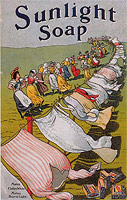 The arrival of detergent changed the face of washdays forever. Effective detergents were developed so households no longer had to make their own soap from animal fat and ash. The arrival of detergent changed the face of washdays forever. Effective detergents were developed so households no longer had to make their own soap from animal fat and ash.
Ready-made cleaning compounds offering cure-all solutions were just starting to win a market, replacing home-made recipes bases on soda, salt and sand. But ‘Black Lead’ was still commonly used for cleaning black iron stoves and grates. Sutton’s marketed a compound under the name ‘Cream of Ammonia’ claiming it was the ideal cleanser and purifier. It had various recommended uses including: “Try it in your morning bath, to remove that tired feeling”; “Cleans and restores colour to the carpet”; “As a detergent, invaluable in the sick room and hospital”; and “For laundry purposes softens hard water, and makes linen white and woollen goods soft”. |
Flying 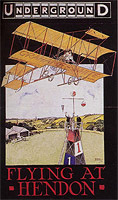 The Wright brothers were the first to get a plane into the air, albeit briefly. Intense experimentation and development followed among those rich enough to afford it and brave enough to try. The Wright brothers were the first to get a plane into the air, albeit briefly. Intense experimentation and development followed among those rich enough to afford it and brave enough to try.
Sadly, some died in the attempt, including Charles Rolls of the Rolls-Royce partnership, who had been the first man to fly both ways across the Channel non-stop. Then the flying of aeroplanes, which were little more than flimsy crafts made of fabric, became a spectator sport, often advertised as a day out. |
Daytrips to the Seaside  The Edwardians loved to spend a day at the seaside. And because of the railways and the bank holiday all classes could enjoy a day out. Even poor children might be treated to one church outing a year. The Edwardians loved to spend a day at the seaside. And because of the railways and the bank holiday all classes could enjoy a day out. Even poor children might be treated to one church outing a year.
Special trains ran popular bank holiday excursions. Southend was a favourite destination for Cockney day-trippers and was popularly known as East London-by-the-sea. Morecambe, Bridlington and, above all, Blackpool were the focus for the industrialised northwest. While seaside resorts advertised themselves, colourful railway company posters also did much to promote the idea of the holiday for all the family, indirectly supplying trade for thousands of boarding houses. The postcard industry flourished, so much so that the postmaster general reported a frenzy of postcard sending, with 613 million in one year alone. |
Suffragettes 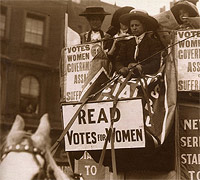 The National Women’s Social and Political Union began its campaign to win women the vote by asking unwelcome questions at political meetings. In the face of vehement and often violent opposition, direct action escalated and included setting fire to pillar boxes, breaking windows and pouring acid on golf links. The National Women’s Social and Political Union began its campaign to win women the vote by asking unwelcome questions at political meetings. In the face of vehement and often violent opposition, direct action escalated and included setting fire to pillar boxes, breaking windows and pouring acid on golf links.
The demonstrators’ uniforms would have been green, white and violet, the initials of which stood for ‘Give Women the Vote’. It was not until the next decade that fanatical suffragette Emily Davison died at the Derby by purposely running into a horse during the celebrated race. It was just the final of many extreme steps she had taken in her desperate battle to gain women the vote. |
|
|


